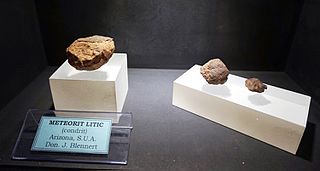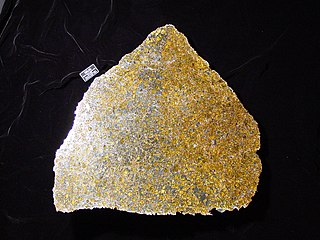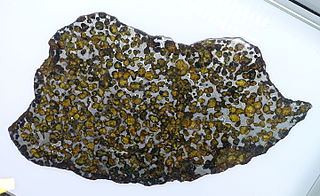
In meteoritics, a meteorite classification system attempts to group similar meteorites and allows scientists to communicate with a standardized terminology when discussing them. Meteorites are classified according to a variety of characteristics, especially mineralogical, petrological, chemical, and isotopic properties.

Sinus Meridiani is an albedo feature on Mars stretching east-west just south of the planet's equator. It was named by the French astronomer Camille Flammarion in the late 1870s.

The pallasites are a class of stony–iron meteorite. They are relatively rare, and can be distinguished by the presence of large olivine crystal inclusions in the ferro-nickel matrix.

Imilac is a pallasite meteorite found in the Atacama Desert of Northern Chile in 1822.

Iron meteorites, also called siderites or ferrous meteorites, are a type of meteorite that consist overwhelmingly of an iron–nickel alloy known as meteoric iron that usually consists of two mineral phases: kamacite and taenite. Most iron meteorites originate from cores of planetesimals, with the exception of the IIE iron meteorite group.

The Fukang meteorite is a meteorite that was found in the mountains near Fukang, China in 2000. It is a pallasite—a type of stony–iron meteorite with olivine crystals. It is estimated to be 4.5 billion years old.

Mesosiderites are a class of stony–iron meteorites consisting of about equal parts of metallic nickel-iron and silicate. They are breccias with an irregular texture; silicates and metal occur often in lumps or pebbles as well as in fine-grained intergrowths. The silicate part contains olivine, pyroxenes, and Ca-rich feldspar and is similar in composition to eucrites and diogenites.

Esquel is a meteorite found near Esquel, a Patagonian town in the northwest part of the province of Chubut in Argentina. It is a pallasite, a type of stony–iron meteorite that when cut and polished shows yellowish olivine (peridot) crystals.

Brenham is a pallasite meteorite found near Haviland, a small town in Kiowa County, Kansas, United States. Pallasites are a type of stony–iron meteorite that when cut and polished show yellowish olivine (peridot) crystals.

Pallasovka is a pallasite meteorite found in 1990 near the town of Pallasovka, Russia.

Seymchan is a pallasite meteorite found in the dry bed of the river Hekandue, a left tributary of river Yasachnaya in the Magadan district, Russia, near the settlement of Seymchan, in June 1967.

Mbozi is an ungrouped iron meteorite found in Tanzania. It is one of the world's largest meteorites, variously estimated as the fourth-largest to the eighth-largest, it is located near the city of Mbeya in Tanzania's southern highlands. The meteorite is 3 metres (9.8 ft) long, 1 metre high, and weighs an estimated 16 metric tons.

The Springwater meteorite is a stony-iron pallasite, found near Springwater, Saskatchewan in 1931. At that time the find consisted of three large masses (38.6 kilograms, 18.6 kilograms and 10.6 kilograms. Other fragments have been found recently, including a 53 kilograms individual in 2009 that is now in the Royal Ontario Museum.

IAB meteorites are a group of iron meteorites according to their overall composition and a group of primitive achondrites because of silicate inclusions that show a strong affinity to winonaites and chondrites.

IIICD meteorites are a group of primitive achondrites. They are classified in a clan together with the IAB meteorites and the winonaites.

The Eagle Station group is a set of pallasite meteorite specimen that do not fit into any of the other defined pallasite groups. In meteorite classification five meteorites have to be found, so they can be defined as their own group. Currently only five Eagle Station type meteorites have been found, which is just enough for a separate group.
IIG meteorites are a group of iron meteorites. The group currently has six members. They are hexahedrites with large amounts of schreibersite. The meteoric iron is composed of kamacite.
The Vermillion meteorite is a pallasite (stony-iron) meteorite and one of two members of the pyroxene pallasite grouplet.
The Winona meteorite is a primitive achondrite meteorite. It is the type specimen and by far the largest meteorite of the winonaite group.
This is a glossary of terms used in meteoritics, the science of meteorites.















